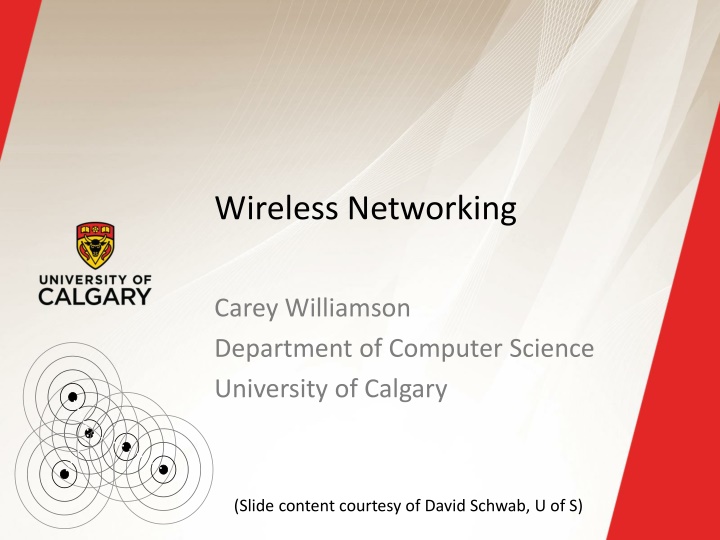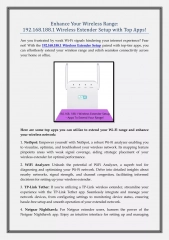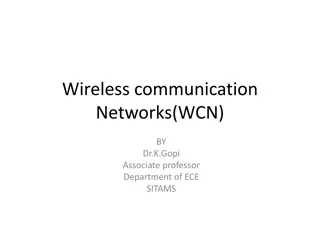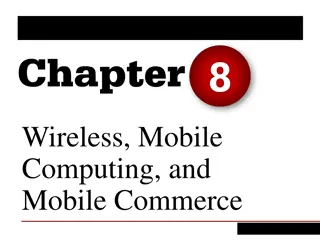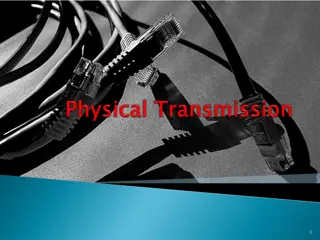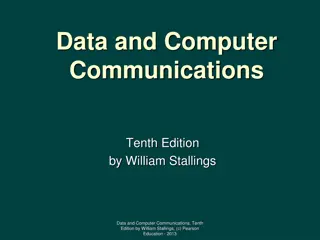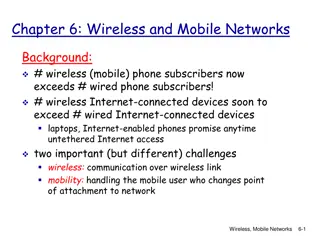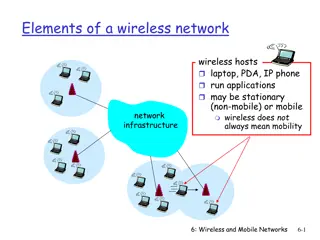Wireless Networking Technologies
The world of wireless networking is diverse and constantly evolving, encompassing technologies such as Bluetooth, IEEE 802.11 standards, ad hoc networks, and more. From high-speed broadband to low-power Bluetooth connections, these technologies enable seamless communication and resource sharing between devices. Dive into the realm of wireless networking to discover its vast potential and applications.
Download Presentation

Please find below an Image/Link to download the presentation.
The content on the website is provided AS IS for your information and personal use only. It may not be sold, licensed, or shared on other websites without obtaining consent from the author.If you encounter any issues during the download, it is possible that the publisher has removed the file from their server.
You are allowed to download the files provided on this website for personal or commercial use, subject to the condition that they are used lawfully. All files are the property of their respective owners.
The content on the website is provided AS IS for your information and personal use only. It may not be sold, licensed, or shared on other websites without obtaining consent from the author.
E N D
Presentation Transcript
Wireless Networking Carey Williamson Department of Computer Science University of Calgary (Slide content courtesy of David Schwab, U of S)
What Is Wireless Networking? The use of infra-red or radio frequency signals to share information and resources between devices A hot computer industry buzzword: Lots of advertising by companies and media Wireless Broadband, 3G/4G/5G, LTE, Bluetooth Mobile Internet, Pervasive Computing, IoT, etc. Ubiquitous Global Revolutionary
Two Popular 2.4 GHz Standards IEEE 802.11 Fast (11b) High power Long range Single-purpose Ethernet replacement Easily Available Apple Airport, iBook, G4 Cisco Aironet 350 Bluetooth Slow Low power Short range Flexible Cable replacement Vapourware Anoto, Test cards, phone
IEEE 802.11 Family Tree: Historical Look IEEE 802.11 Working Group PHYS Layer MAC Layer Infra-Red (IR) 2.4 GHz (FHSS) 2.4 GHz (DSSS) 5 GHz (OFDM) 802.11 MAC 802.11 IR 1 / 2 Mbit/s 802.11 FHSS 1 / 2 Mbit/s 802.11 DSSS 1 / 2 Mbit/s 802.11a 6 / 12 / 24 Mbit/s Optional 9/18/36/54 Mbit/s 802.11e MAC Enhancements 802.11b High Data Rate Extension 5.5 / 11 Mbit/s Security QOS 802.11g Data Rates > 20 Mbit/s
Pros and Cons of 802.11b Pro: High bandwidth (up to 11 Mbps) Two modes of operation: infrastructure vs. ad hoc Con: Incompatibility between old and new cards Signal blocked by reinforced concrete or tinted glass High channel BER can degrade performance (lots!) No standard for hand-off between base stations Some channel numbers overlap in spectrum High power consumption in laptops
Multi-Hop Wireless Ad Hoc Networks Routing protocols used to improve wireless connections Infrastructure-free, dynamic True Peer-to-Peer routing Fault tolerant Examples: AODV, DSDV, TORA, DSR, ...
Bluetooth Think USB, not Ethernet Created by Ericsson PAN - Personal Area Network 1-2 Mbps connections 1600 hops per second FHSS Includes synchronous, asynchronous, voice connections Piconet routing Small, low-power, short-range, cheap, versatile radios Used as Internet connection, phone, or headset
Wireless Security Issues Wireless networks are broadcast networks Wireless sniffers IEEE 802.11: ESSID Extended Services Set ID WEP Wired Equivalent Privacy 40 bit RC4 (RSA) encryption Bluetooth Security Rapid hop sequence Short range Encrypted transmissions
Wireless Mesh Networking An alternative to traditional ISPs and wired Internet A grassroots movement established in 1996 802.11 Wireless LAN cards Roof mounted antennae Free software (FreeBSD) Multi-hop routing, Internet connectivity Cheap nodes, and lots of them Public wireless mesh networks popular in many large cities, including San Francisco, Seattle, London,
Future of Wireless Better mobility support Better security Wider selection Lower prices Less configuration required More end-user focus Better software Less visible More popular
